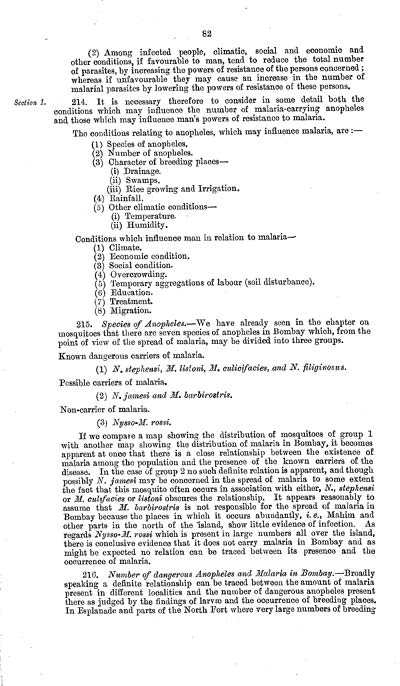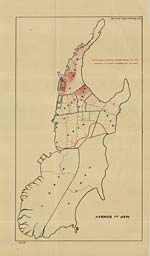Medicine - Disease > Report of an investigation into the causes of malaria in Bombay and the measures necessary for its control
(121) Page 82
Download files
Individual page:
Thumbnail gallery: Grid view | List view

82
(2) Among infected people, climatic, social and economic and
other conditions, if favourable to man, tend to reduce the total number
of parasites, by increasing the powers of resistance of the persons concerned;
whereas if unfavourable they may cause an increase in the number of
malarial parasites by lowering the powers of resistance of these persons.
Section 1.
214. It is necessary therefore to consider in some detail both the
conditions which may influence the number of malaria-carrying anopheles
and those which may influence man's powers of resistance to malaria.
The conditions relating to anopheles, which may influence malaria, are:-
(1) Species of anopheles,
(2) Number of anopheles.
(3) Character of breeding places-
(i) Drainage.
(ii) Swamps.
(iii) Rice growing and Irrigation.
(4) Rainfall.
(5) Other climatic conditions-
(i) Temperature.
(ii) Humidity.
Conditions which influence man in relation to malaria-
(1) Climate.
(2) Economic condition.
(3) Social condition.
(4) Overcrowding.
(5) Temporary aggregations of labour (soil disturbance).
(6) Education.
(7) Treatment.
(8) Migration.
215. Species of Anopheles.-We have already seen in the chapter on
mosquitoes that there are seven species of anopheles in Bombay which, from the
point of view of the spread of malaria, may be divided into three groups.
Known dangerous carriers of malaria.
(1) N. stephensi, M. listoni, M. culicifacies, and N. filiginosus.
Possible carriers of malaria.
(2) N. jamesi and M. barbirostris.
Non-carrier of malaria.
(3) Nysso-M. rossi.
If we compare a map showing the distribution of mosquitoes of group 1
with another map showing the distribution of malaria in Bombay, it becomes
apparent at once that there is a close relationship between the existence of
malaria among the population and the presence of the known carriers of the
disease. In the case of group 2 no such definite relation is apparent, and though
possibly N. jamesi may be concerned in the spread of malaria to some extent
the fact that this mosquito often occurs in association with either, N., stephensi
or M. culifacies or listoni obscures the relationship. It appears reasonably to
assume that M. barbirostris is not responsible for the spread of malaria in
Bombay because the places in which it occurs abundantly, i. e., Mahim and
other parts in the north of the island, show little evidence of infection. As
regards Nysso-M. rossi which is present in large numbers all over the island,
there is conclusive evidence that it does not carry malaria in Bombay and as
might be expected no relation can be traced between its presence and the
occurrence of malaria.
216. Number of dangerous Anopheles and Malaria in Bombay.-Broadly
speaking a definite relationship can be traced between the amount of malaria
present in different localities and the number of dangerous anopheles present
there as judged by the findings of larv and the occurrence of breeding places.
In Esplanade and parts of the North Fort where very large numbers of breeding
(2) Among infected people, climatic, social and economic and
other conditions, if favourable to man, tend to reduce the total number
of parasites, by increasing the powers of resistance of the persons concerned;
whereas if unfavourable they may cause an increase in the number of
malarial parasites by lowering the powers of resistance of these persons.
Section 1.
214. It is necessary therefore to consider in some detail both the
conditions which may influence the number of malaria-carrying anopheles
and those which may influence man's powers of resistance to malaria.
The conditions relating to anopheles, which may influence malaria, are:-
(1) Species of anopheles,
(2) Number of anopheles.
(3) Character of breeding places-
(i) Drainage.
(ii) Swamps.
(iii) Rice growing and Irrigation.
(4) Rainfall.
(5) Other climatic conditions-
(i) Temperature.
(ii) Humidity.
Conditions which influence man in relation to malaria-
(1) Climate.
(2) Economic condition.
(3) Social condition.
(4) Overcrowding.
(5) Temporary aggregations of labour (soil disturbance).
(6) Education.
(7) Treatment.
(8) Migration.
215. Species of Anopheles.-We have already seen in the chapter on
mosquitoes that there are seven species of anopheles in Bombay which, from the
point of view of the spread of malaria, may be divided into three groups.
Known dangerous carriers of malaria.
(1) N. stephensi, M. listoni, M. culicifacies, and N. filiginosus.
Possible carriers of malaria.
(2) N. jamesi and M. barbirostris.
Non-carrier of malaria.
(3) Nysso-M. rossi.
If we compare a map showing the distribution of mosquitoes of group 1
with another map showing the distribution of malaria in Bombay, it becomes
apparent at once that there is a close relationship between the existence of
malaria among the population and the presence of the known carriers of the
disease. In the case of group 2 no such definite relation is apparent, and though
possibly N. jamesi may be concerned in the spread of malaria to some extent
the fact that this mosquito often occurs in association with either, N., stephensi
or M. culifacies or listoni obscures the relationship. It appears reasonably to
assume that M. barbirostris is not responsible for the spread of malaria in
Bombay because the places in which it occurs abundantly, i. e., Mahim and
other parts in the north of the island, show little evidence of infection. As
regards Nysso-M. rossi which is present in large numbers all over the island,
there is conclusive evidence that it does not carry malaria in Bombay and as
might be expected no relation can be traced between its presence and the
occurrence of malaria.
216. Number of dangerous Anopheles and Malaria in Bombay.-Broadly
speaking a definite relationship can be traced between the amount of malaria
present in different localities and the number of dangerous anopheles present
there as judged by the findings of larv and the occurrence of breeding places.
In Esplanade and parts of the North Fort where very large numbers of breeding
Set display mode to: Large image | Zoom image | Transcription
Images and transcriptions on this page, including medium image downloads, may be used under the Creative Commons Attribution 4.0 International Licence unless otherwise stated. ![]()
| India Papers > Medicine - Disease > Report of an investigation into the causes of malaria in Bombay and the measures necessary for its control > (121) Page 82 |
|---|
| Permanent URL | https://digital.nls.uk/74573238 |
|---|




